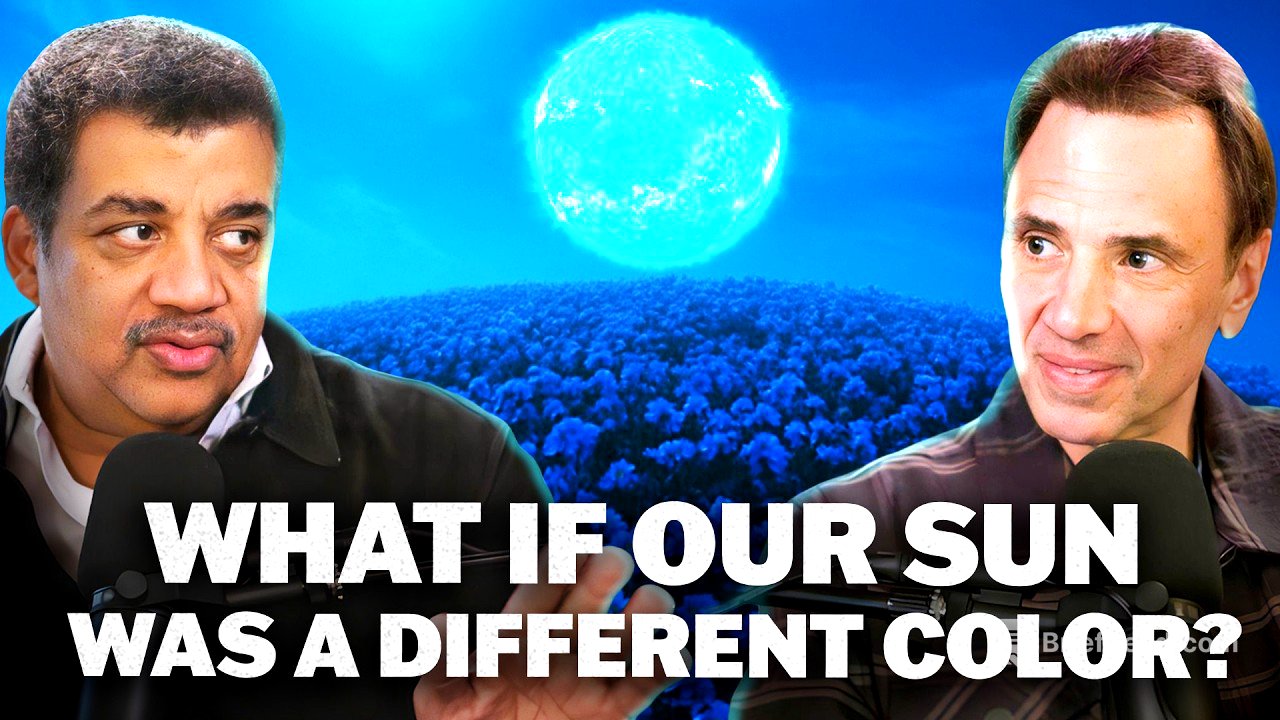TLDR;
In this episode of StarTalk, Neil deGrasse Tyson and comedian Paul Mccurio tackle a series of cosmic queries, ranging from the implications of time travel to the nature of black holes and the perception of color in different stellar environments. They explore the question of what aliens might ask humans upon first contact, the possibility of using the cosmic microwave background as a universal clock, and the effects of mass-energy conversion on gravity.
- Time travel requires spatial movement to account for the solar system's orbit.
- The colonization intentions of humans would be a primary concern for aliens.
- Black holes will eventually outnumber stars, though not their corpses.
- The speed of light is a fundamental constant, and measurements are always subject to uncertainty.
- Our perception of color is influenced by the type of star we orbit.
Introduction: Grab Bag [0:00]
Neil deGrasse Tyson introduces Paul Mccurio as his guest for a "cosmic queries grab bag" episode. Mccurio promotes his Broadway show, "Permission to Speak," directed by Frank Oz, and his podcast, "Inside Out." Tyson explains the grab bag format, where he answers questions without prior knowledge, and jokes about his co-host Chuck.
Time Machines Are Also Space Machines [1:56]
The first question addresses the concept of time travel and whether a time machine would also need to be a space machine. It's explained that time travel necessitates movement in space to compensate for the solar system's orbit around the galaxy. Otherwise, a traveler going back in time would end up in empty space. The movie "Back to the Future" is cited as an example where the date selection avoided this issue.
If You Were an Alien, What Would You Ask Humans? [6:53]
The discussion shifts to what an alien life form on a pristine planet might ask humans upon their arrival. Mccurio suggests the primary concern would be whether the humans intend to colonize the planet, given humanity's history. Tyson references "The Twilight Zone" episode "The Invaders" and suggests that aliens might question the value humans place on superficial things like emojis and celebrity culture. They also ponder how aliens might assess humanity's capacity for self-destruction and potential biases.
Will There Be More Black Holes Than Stars One Day? [12:30]
The question is posed whether black holes will eventually outnumber stars in the distant future. Tyson confirms that while black holes do evaporate slowly over time, there will indeed come a point when they outnumber living stars, though not the corpses of stars. The conversation touches on the initial mass function, which favors the creation of low-mass stars over high-mass stars that become black holes.
The Cosmological Constant [16:31]
The discussion explores the speed of light and whether its value is arbitrary. Tyson clarifies that while the units used to measure the speed of light are arbitrary, the speed itself is a fundamental constant. He explains how precisely the speed of light has been measured, to the point where it defines the length of the meter. Mccurio raises the point that there is always uncertainty in every measurement.
Wormholes & Gravity [21:37]
The nature of wormholes and their relationship to gravity is examined. Tyson explains that wormholes would use negative gravity to create a shortcut through space-time. He also notes that if wormholes existed, they would render transporters obsolete in "Star Trek." The discussion touches on how we would perceive a wormhole if we are three-dimensional beings and how higher-dimensional objects manifest in our dimensionality.
What If We Orbited a Blue Star? [27:22]
The question is asked how our world would look if we orbited a blue or red star instead of our white star. Tyson explains that if we evolved under a blue star, our eyes would likely have adapted to see different shades of blue. He also discusses how scientists create color photographs from infrared data by assigning RGB values to different wavelengths.
Is the Cosmic Microwave Background a Universal Clock? [32:06]
The possibility of using the cosmic microwave background (CMB) as a universal clock is considered. Tyson confirms that the CMB's temperature can be used to determine the age of the universe, as every part of the universe was in the same place at the same time 13.8 billion years ago. He draws an analogy to forensic scientists using body temperature to determine the time of death.
Opposite of the Speed of Light [34:19]
The discussion explores what might exist on the other side of the speed of light. Tyson introduces the concept of tachyons, hypothetical particles that would exist faster than light and travel backward in time. While tachyons have never been found, their existence is allowed by Einstein's equations. The conversation touches on how time would work for an object with no gravity and no movement, suggesting it would experience time speeding up.
Bouyancy [39:14]
The principle of buoyancy is explained. Tyson states that buoyancy is all about density and gravity. An object will float if it is less dense than the medium it is immersed in. The conversation touches on how metal ships can float due to their shape displacing water and creating an overall density less than water.
What Happens to Gravity in Mass-Energy Conversion? [42:31]
The question is posed about what happens to gravity when mass is converted to energy in nuclear fission and fusion. Tyson clarifies that gravity emanates from both mass and energy, as they are two sides of the same coin. Therefore, the gravity associated with the lost mass is not lost but is instead associated with the energy created.
How Many Supernovae Are We Made of? [44:38]
The final question asks whether our solar system is comprised of remnants from a single supernova or a collection of many. Tyson explains that supernovas scatter their guts everywhere, and the galaxy's differential rotation mixes the detritus of multiple supernova explosions over time. As a result, the next generation of stars, including our sun, contains ingredients from many previous supernovas.









![[EXPLAINED🍄] AI Agents vs. Workflows](https://wm-img.halpindev.com/p-briefread_c-10_b-10/urlb/aHR0cDovL2ltZy55b3V0dWJlLmNvbS92aS94cWNsOWRBQWtDMC9ocWRlZmF1bHQuanBn.jpg)